Do-it-yourself gas heater: instructions to help home craftsmen
With the onset of cold weather, there is a need to heat the premises. It is not always possible to provide central or autonomous heating to premises such as a garage, barn, paddock, or greenhouse.The reasons may be different: lack of funds due to the high cost of connecting such systems or lack of technical capabilities.
If you make a gas heater with your own hands, it will effectively heat utility rooms. Now on the market you can choose and buy many different models of gas heaters at different prices and with different characteristics. However, the price includes a steep seller's markup.
We will tell you how to assemble an almost free homemade product from available materials. Here you will find a detailed description of homemade devices and instructions on how to make them. To help do-it-yourselfers, we offer assembly guides and valuable advice.
The content of the article:
Features of a homemade design
The main task that the future homemade device will perform is heating a room, tent, garage and other premises. When assembling it yourself, the appearance of the device and its decorative qualities fade into the background.
An important role will be played by the sufficiency of the amount of heat generated, the safety of operation and the ease of transportation of the device.
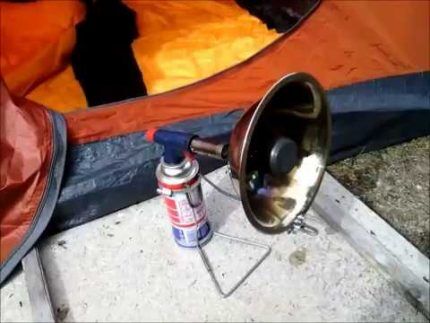
For heating purposes, a variety of homemade gas structures are used. Making heaters from gas burners or gas stoves with your own hands is not difficult. For quick assembly, you will need a pre-prepared diagram, the material from which the heater will be made, and a variety of tools.
Often a homemade gas heater is taken on a camping trip outside the city or on a fishing trip, on trips, to various gatherings as a source of additional heat. In such cases, it will be enough to assemble the device, check its functionality, inspect it for leaks and proceed directly to heating.
Sometimes homemade heater planned to be used as an alternative heating source. For example, in a country house, in a barn, in a paddock, in a garage and in other premises in order to save money on utility bills and on the purchase of gas equipment.

In such cases, care must be taken to minimize heat loss within the heated room. This is done by insulating the external and internal walls, floor and ceiling of the structure. It is most effective to carry out simultaneous internal and external insulation procedures. Then the heat will last as long as possible, and gas consumption will be much reduced.
If it is not possible to carry out two types of insulation at the same time, then you need to insulate the building at least from the inside. It's more efficient. When carrying out the procedure, it is necessary to use a material suitable for thermal insulation, as well as fire-resistant materials and coatings.
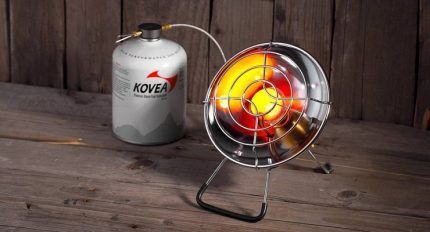
When using gas equipment, you must always observe safety precautions and adhere to the rules for installing equipment and insulating premises. If a heated building is finished with fireproof materials, then it will be fire resistant. This significantly reduces the risk of fire and unexpected fires.
It is best to place a homemade gas heater in the center of the heated room. In this case, the generated heat is not lost or absorbed by the walls, since there is no contact with them. Warm air will go up to the ceiling of the room. If you also install special reflectors on the ceilings, the effect of a thermal cap will be created in the room.
This positive phenomenon allows you to significantly save money on space heating using homemade gas structures. Warm air circulates throughout the space and does not leave it. It is worth knowing that the heat cap effect is created when the heater emits a sufficiently intense air flow.
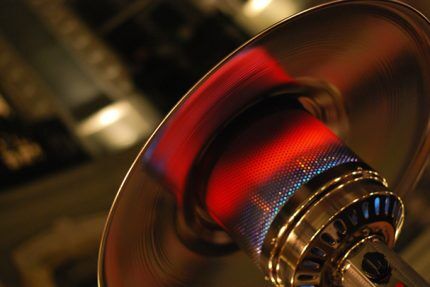
Based on the results of assembly, a homemade heating device should have the following parameters:
- safe and easy operation;
- economical consumption of energy resources, in this case gas;
- efficient and fast heating of rooms;
- quick start of the device, possibility of long-term operation;
- ease of assembly and ease of replacement of failed parts;
- possibility of transporting the device;
- sizes convenient for carrying, transportation and operation.
All of the above characteristics are quite difficult to fit into one design.However, some craftsmen manage to independently make a gas heater of sufficient power, convenient, easy to use, which serves the user for a long time.
The advantages of homemade gas heaters include:
- Economical work. Sometimes one full cylinder can be enough for 12 hours of continuous operation of the device. Of course, it all depends on the size of the cylinder.
- Ability to quickly turn on and off.
- Compact and light weight. Some homemade designs are convenient to take on hikes. They do not take up much space and weigh several kilograms. And the beneficial effect of their use is difficult to underestimate.
Among the disadvantages of home-made structures, the need to select suitable cylinder or the presence of an adapter. Therefore, you need to take care of purchasing additional cans in advance. Or be able to transfer gas from a large cylinder into a small tank.

Some self-made gas heaters cannot withstand severe subzero temperatures and will not start if the air temperature is below a certain level. Facing such a problem can overshadow a tourist trip. However, indoor temperatures usually do not drop to very low levels.
If the heater operates indoors, it is necessary to ensure the supply of fresh air. It is also important to consider that the level of carbon dioxide indoors increases. Air humidity decreases significantly.
Do not leave the device turned on unattended, or bring flammable objects near it. This may cause fire and ignition.
The operating efficiency of a self-constructed device is determined by its basic characteristics.
Efficiency. This indicator is determined by the ratio of the energy that is used for heating to the energy that is spent to generate it. Gas heaters have different efficiency values.
Device safety. Often, on home-made structures, the installation of devices that ensure safe operation is neglected: valves, sensors that automatically turn off the burner.
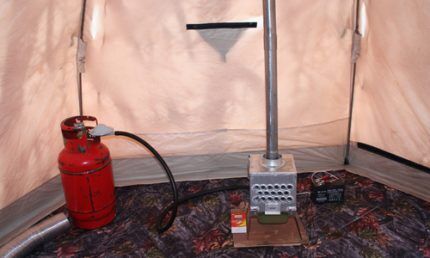
Fuel consumption and area heated by the device. Depending on the size of the device, fuel consumption also changes. The larger the room, the larger the burner will be required.
Gas heater device
All structures are united by a single gas supply system. The fuel source is gas cylinders with propane-butane or other types of gas mixtures. Gas cartridges for burners are also used for small heaters. You can carefully fill and pour them with your own hands. The main thing is to follow safety precautions.
Many homemade gas heaters operate on the principle infrared radiation. It consists in the fact that the fuel gradually burns in the burner and thereby heats the heating element, which, in turn, releases heat in the infrared range.In this way, all objects in the room or tent are heated. After this, the heat is released into the air.
Do-it-yourself gas heaters are quite diverse and can have different weights from half a kilogram to ten kilograms. It all depends on the complexity of the design and the required level of heat generated at the output.

Typically, homemade products are constructed from the following basic elements:
- fans that evenly distribute heated air throughout the room;
- power regulator that allows you to adjust the level of heat generated and room temperature;
- gas burner, which directly burns gas and heats the system;
- thermal emitter - an element that accumulates thermal energy and releases it into the air or onto objects in the room;
- grilles that protect the heat emitter from direct contact with objects.
In addition to the main elements, additional ones will be required, which may include handles, grilles, reflectors, covers, fasteners, gas hoses and other preparations.
A device made in this way is suitable for heating small and medium-sized rooms and small spaces. There is no need for electrical appliances or electricity. When the next cylinder is used up, it can be refilled or a new one can be purchased.

Some homemade gas infrared heaters also perform additional functions, which include heating water, drying clothes and various items.Some devices can also be used to cook food. At night, such a heater glows and is a source of additional lighting.
Homemade device from a gas burner
Using the method we propose, you can assemble a not too powerful, but convenient, compact, portable gas heater. This device is suitable for heating small rooms, a garage, a small greenhouse, a basement or a tent.
To assemble the structure, a gas stove-primus burner is used. It is used for cooking. This scheme is also applicable when using collet valve cylinders.
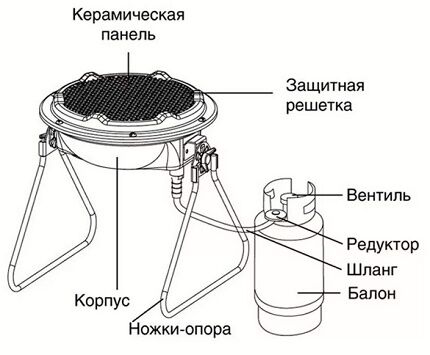
In addition to the burner, you will need the following available materials:
- small sheet of tin;
- round metal sieve;
- rivets.
You will also need some tools: an electric drill with a small drill bit, a riveting device and metal scissors.
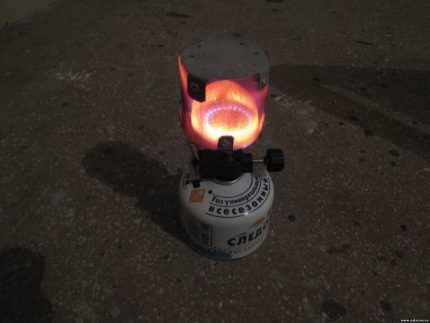
The device is assembled as follows. First you need to take a pre-prepared tin sheet and attach a sieve to it. The sieve must be outlined around the circumference with a marker or construction pencil.
After this, a sieve is put aside and rectangular ears or the so-called development are carefully drawn on top of the circle using a pencil and a ruler. One ear should be slightly longer than the other three.
Then you need to take scissors and carefully cut out the lined blank. It is important to cut the parts so that there are no irregularities on their surface.
After the circle is cut from the sheet, it must be attached to the burner using bolts. To do this, you will need a drill, with which you carefully drill even holes. Then you need to straighten the drilled holes and erase the remaining metal with a file or cut (sharpen) with a grinder.
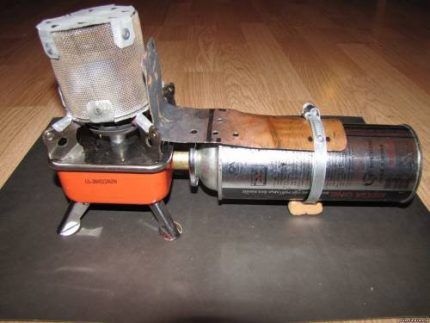
At the top of the resulting structure you need to bend the rectangular ears and attach a metal sieve. The main task of the sieve during operation of the heater will be to dissipate heat. This design can be improved by additional use of mesh.
First of all, another circle with ears is additionally cut out of the tin sheet. Its dimensions must match the dimensions of the first part. Then, using a drill, you need to drill holes in the cut out circle, which should be located at a short distance from the edge of the workpiece. After this, you need to cut a small strip from the mesh.
A cut out narrow strip is attached above the sieve to the first and second tin circle by the ears using rivets. The ears should be bent at a 90 degree angle. As a result, the structure will resemble a metal cylinder.
After making such a gas heater with your own hands using a gas burner, the design must be checked. You need to make sure that it can be used safely. The gas cartridge is connected to the burner, the gas supply is turned on, the burner is ignited, and the device begins heating the room.
Using an adapter hose, you can connect such a burner to a large gas cylinder.Then you won’t have to waste additional time replacing and refilling the gas container. The cylinder must have gas reducer, which protects the structure from the reverse movement of gas and allows you to regulate the pressure.
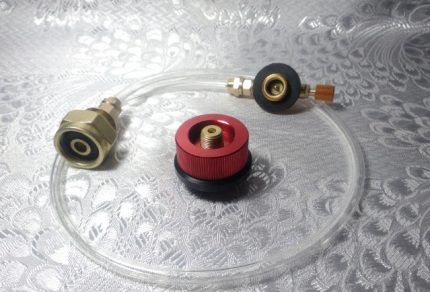
It is worth remembering that manufacturers of gas cartridges do not recommend reusing their products and refill the cans.
Using a similar approach, you can design a larger homemade gas heater. Such devices will already resemble gas stoves and can be powered directly from a gas pipe or a large cylinder. Naturally, the power of such a stove will be enough to heat a larger room.
However, such structures are not so easy to move from one place to another, they take up a lot of space and often require additional construction of a chimney and a ventilation system.
Portable tile heater
Small rooms, a garage, a greenhouse, a tent can be conveniently heated with a portable tabletop gas heater. Such a device is constructed from a quadrangular flat tile equipped with a metal grid.
Assembling this device involves attaching part of the gas stove to a metal casing. Due to the installed combustion chamber, the air is heated to the desired temperature, and several or one fan ensures the supply of warm air and its circulation throughout the room. The assembly of such a device consists of several stages and does not require special technical knowledge.
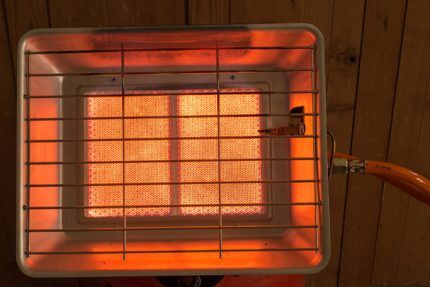
The first stage is working with measuring tools. You need to use a ruler or tape measure to take accurate measurements from the quadrangular tile. This will be required to determine the parameters of the heater housing. After taking measurements, you need to cut out blanks from a tin sheet using scissors. Next, the blanks are fastened with rivets into a casing.
Then the casing is fixed with hook strips on the tile. In order for it to be quickly removed and mounted back, you need to make a movable bar. Such a bar can be easily made using a small spring, which is connected to a lifting lever.
Thanks to this solution, in the future it will be possible to easily remove the casing for cleaning or transportation. The homemade scheme under consideration assumes the presence of a special ventilation system. To install it you will need a simple fan without any additional complex devices or materials.
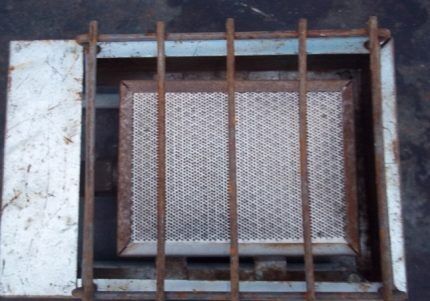
A small fan from any home device is suitable for installing ventilation. You can use scissors to adjust the size. Trimming and giving the desired shape and size to the fan blades takes about half an hour. After carrying out these steps, you need to install a ready-made fan behind the heater housing so that there is draft inside the housing.
You also need to install a metal combustion chamber. The combustion chamber body must be studded with many small holes. They can be made using an electric drill and a metal drill or using a hammer and nail. The holes should be a short distance from each other.
You also need to purchase a rubber hose with an adapter for connecting flat tiles to gas pipe or gas cylinder. A fan installed at the rear of the casing ensures the supply and distribution of warm air over a fairly wide range in the heated space.
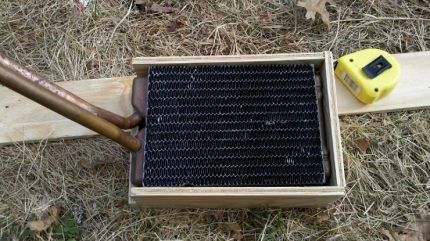
Such a homemade gas heater copes well with the task of heating a room not only in the autumn-spring period, but even in winter. Also, such a device consumes gas economically and has a high efficiency.
Construction of a heater from a pipe
This homemade design is also called thermal gas gun. It produces significantly more heat than previous heaters and absorbs more energy resources. Also, such structures are often equipped with chimneys, which makes them bulky and difficult to carry.

To assemble the heater yourself, you need to collect the following material:
- three meter pipes of various diameters (two 8 cm and one 18 cm);
- steel plates with which the fastening will be carried out;
- Metal sheet;
- gas burner with piezo ignition;
- axial fan.
You will also need a variety of tools: drill, welding machine, tape measure, level, grinder, metal scissors. Pipes can be replaced with cylinders or fire extinguishers of suitable diameters. A grinder will be needed to cut the bottom and top, as well as shorten the workpieces.
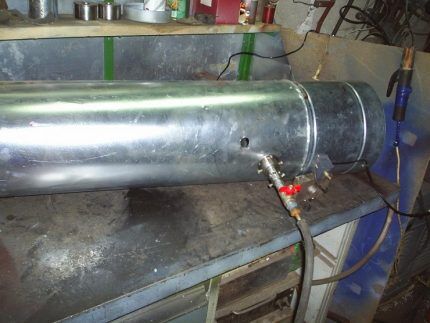
In a pipe with a diameter of 18 cm, two holes of different diameters are drilled: 1 cm and 8 cm. They need to be drilled opposite each other.
A 30 cm section is cut from a pipe with a diameter of 8 cm, which will represent the combustion chamber. Fasteners are welded to this pipe and a hole with a diameter of 1 cm is drilled in it. Then this pipe is inserted into the first pipe.
You need to cut a plug from a sheet of metal. It will close the gap between the heater body and the combustion chamber. A combustion chamber is welded to the body, and a pipe for exhausting hot air is welded to a hole with a diameter of 8 cm. After this, the plug is welded. After making sure that the gas burner is tightly attached to the combustion chamber, you can insert the hose through the centimeter holes.
A fan is installed at the back of the device, and a smoke exhaust is installed at the top. In order for the heater to stand stably on the surface, the legs should be welded. A gas heat gun efficiently heats rooms and uses gas economically. However, when using it, you should adhere to safety precautions.
Conclusions and useful video on the topic
Gas heater from a tin can:
Homemade infrared gas heater:
Anyone can assemble a gas heater according to the schemes discussed at home. You just need to follow safety precautions and not neglect the instructions for putting the devices into operation. If you assemble the heater yourself, you can save money. In addition, the efficiency and performance of such devices is not inferior to store-bought ones.
If you plan to heat a small room or tent, and also take the device on trips and hikes, then it is better to make a heater from a gas burner or from a gas stove. They are more compact, take up less space and are easy to transport. Gas heaters are suitable for heating larger spaces, produce more heat and require an electrical connection to operate the fan.



